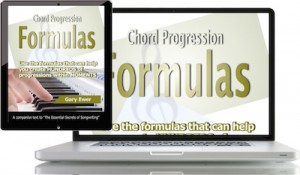A verse-chorus chord progression pair refers to two progressions that move seamlessly one to the other, where one has those characteristics of a good verse progression and the other acts as a good chorus one.
Before giving examples of these types of pairs, keep in mind that the easiest way is to create one progression that will work in both the verse and the chorus. In other words, one progression for both sections.
 A chord progression formula is a powerful tool for instantaneously creating dozens of progressions, all of which you know will work! “Chord Progression Formulas” is part of “The Essential Secrets of Songwriting” 10-eBook Bundle.
A chord progression formula is a powerful tool for instantaneously creating dozens of progressions, all of which you know will work! “Chord Progression Formulas” is part of “The Essential Secrets of Songwriting” 10-eBook Bundle.
These kinds of progressions should be strong, which means the following:
- The key is clear. This means a progression that strongly indicates the key and doesn’t divert (at least not much) from that key. Example: C Dm F G, or C Bb F C.
- The progression is short. Don’t allow the progression to wander or become overly long and involved. Four or five chords should do it.
- The harmonic rhythm simple and predictable. Harmonic rhythm refers to how frequently the chords change. In strong progressions, you’ll want to do something predictable, like changing chords every 2, 4 or 8 beats.
But lets say you want to create a verse progression, and then switch to something entirely different for the chorus. (This is the case for the majority of songs.)
If that’s the case, you’ll want your chorus progression to exhibit the 3 characteristics I’ve listed above: a short progression with a clear indication of key, in which the chords change in a predictable pattern.
Verse progressions can be a little different. A verse progression may:
- ..be longer than a chorus progression.
- ..can subtly avoid the key of the chorus. For example, your chorus may clearly indicate C major (C Dm F G C). So it can be interesting if you verse focuses more on a minor chord from that key… A minor, for example: Am G Am Dm…
- ..use more inversions (slash chords) than a chorus might.
What To Look For In a Verse-Chorus Pairing
So what specifically makes a verse-chorus pair of chord progressions really work well? In practically every case, a verse-chorus pair works nicely when the listener senses the music moving from a “fragile” state to a “strong” state.
That might mean, for example, a chord progression that sounds wandering and hard to pin down regarding key, moving to a progression that’s shorter and much clearer with regard to key.

5 Verse-Chorus Progression Pair Examples
So here’s a short list of progressions you can try. They’ll work in any key, so feel free to transpose. They’ll also work for most genres, and (especially with regard to the verse examples) feel free to modify and otherwise experiment with them.
Example 1:
Verse: Am G Am Em F G Em (repeat as necessary)
Chorus: C F Am G C F Am G (repeat..)
Description: The verse focuses on minor chords from C major (particularly Am), and the chorus focuses on major (C).
Example 2:
Verse: C F D E7 Am Am/G F D/F# G Em F C Dm Em F G
Chorus: C F C F C F C/G G
Description: The verse is long, wandering through several key areas. The chorus is short, and unambiguously in C major.
Example 3:
Verse: Dm Em Dm Em F Bb F Em (repeat as necessary)
Chorus: C Dm C Dm Em F Gsus G
Description: It’s hard to nail down the key by ear for most listeners, but that’s OK since each chord sounds like a logical follower to the one that came before it. The chorus progression is typically shorter and stronger.
Example 4:
Verse: G G/F C/E Cm/Eb G/D D F G
Chorus: C C/Bb Am G
Description: The verse sounds like G major, and uses a mainly downward moving bass line. The switch to the chorus moves the progression clearly into C major, still using the descending bass line as a kind of musical motif.
Example 5:
Verse: C F Dm G Em Am F G
Chorus: C G Dm G
Description: The verse progression is quite strong and predictable, solidly in C major. The chorus progression is much shorter, so the only real difference between verse and chorus is the length of the progression. Both those progressions, by the way, would work well in a chorus.
Pre-Chorus Tips
Most of these verse-chorus pairs would work well with a pre-chorus progression inserted in between. A pre-chorus is a short section between the verse and the chorus, and usually serves to build up some musical energy and make the chorus “more welcome.” If you find that the chorus sounds as if it’s happened too soon, try inserting 4 bars or so, something that generates musical energy toward the first chord of the chorus.
In the first chord progression example above, for example, this might work as a good pre-chorus progression: Dm Em F Em |Dm Em F G.
 Written by Gary Ewer. Follow on Twitter.
Written by Gary Ewer. Follow on Twitter.
“Essential Chord Progressions” give you hundreds of progressions you can use as is, or modify to suit the songs you’re working on. If all you need are some chords to get you going, check out this ebook collection. Read more..
give you hundreds of progressions you can use as is, or modify to suit the songs you’re working on. If all you need are some chords to get you going, check out this ebook collection. Read more..











Thank you for sharing! Great info, very well organized and I really the the description that you write after each chord progression!
Thanks for the great songwriting guides.
Hello mate,, Ive just begun learning the keyboard and more to the point finally writing the 100’s of song fragments that have been swirling inside my soul for a lifetime. Always been a singer, but I have been bitten by the writing bug,, have an iPad and GarageBand which opens doors I never had before. But I spend 100’s of hours, going around in circles because I cannot seem to find anyone to tell me the chord changing rules between verse, chorus, pre chorus, bridge ect. I know these are so very important to know, so the song feeds the way it needs too , to deliver
Everything it can. Can you please help me. ?
Hi Paul:
A number of years back I wrote a blog post, “How Chord Progressions Change as a Song Progresses” – I wonder if you might find that article useful. I had been planning to write a new article that was a bit more comprehensive than that one, and perhaps I’ll have time to do that this week.
I’d recommend giving that post a read, so that you understand the difference between “fragile” and “strong” progressions. And then here’s a quick summary:
1. Verse: Use mainly strong or fragile progressions.
2. Pre-chorus: Create progressions that start on a chord other than the tonic chord, and then move back to the tonic before it hits the chorus. (Or if the chorus begins on the tonic, let the final chord of the pre-chorus be something that moves smoothly to it (like a ii, V or IV).
3. Chorus: Use mainly strong progressions.
4. Bridge: Start on a chord other than the tonic. If your song is in a major key, try starting your bridge on a vi chord, or perhaps ii. If your song is in a minor key, experiment with starting a bridge on the relative major. Use bridge progressions to give a contrast to whatever the chorus is giving.
I hope that helps. Be watching for a new post on this later this week.
-Gary